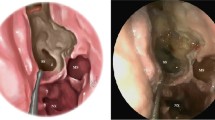Abstract
A nervous branch which passes through a small canal in the sphenozygomatic suture is sometimes observed during dissection. To examine the origin, course and distribution of this nervous branch, 42 head halves of 21 Japanese cadavers (11 males, 10 females) and 142 head halves of 71 human dry skulls were used. The branch was observed in seven sides (16.7%); it originated from the communication between the lacrimal nerve and the zygomaticotemporal branch of the zygomatic nerve or from the trunk of the zygomatic nerve. In two head halves (4.8%), the branch pierced the anterior part of the temporalis muscle during its course to the skin of the anterior part of the temple. The small canal in the suture was observed in 31 head halves (21.8%) of the dry skulls. Although this nervous branch is inconstantly observed, it should be called the temporal branch of the zygomatic nerve according to the constant positional relationship to the sphenoid and zygomatic bones. According to its origin, course and distribution, this nervous branch may be considered to be influential in zygomatic and retro-orbital pain due to entrapment and tension from the temporalis muscle and/or the narrow bony canal. The French version of this article is available in the form of electronic supplementary material and can be obtained by using the Springer LINK server located at http://dx.doi.org/10.1007/s00276-002-0027-4
Résumé
Un rameau nerveux passant par un petit canal de la suture sphéno-zygomatique est parfois observé au cours de la dissection. Pour déterminer l'origine, le trajet, la distribution de ce rameau nerveux, nous avons utilisé 42 moitiés de têtes de 21 cadavres japonais (11 hommes et 10 femmes) et 71 crânes humains secs. Le rameau a été observé sur 7 côtés (16,7%). Il naissait du rameau communicant unissant le nerf lacrymal et le rameau zygomatico-temporal du nerf zygomatique, ou du tronc même du nerf zygomatique. Sur 2 moitiés de tête (4,8%), le rameau traversait la partie antérieure du muscle temporal avant d'atteindre la peau de la partie antérieure de la tempe. Le petit canal dans la suture sphéno-zygomatique a été observé sur 31 moitiés de tête (21,8% des crânes secs). Bien que le rameau nerveux soit observé de façon inconstante, il pourrait être nommé le rameau temporal du nerf zygomatique en raison de ses rapports constants avec les os sphénoïde et zygomatique. En fonction de son origine, de son trajet et de sa distribution, ce rameau nerveux pourrait être considéré comme source potentielle de douleurs zygomatiques et rétro-orbitaires lors de sa compression ou de sa mise en tension à partir du muscle temporal ou du canal osseux étroit.
Similar content being viewed by others
Author information
Authors and Affiliations
Additional information
Received: 1 June 2001 / Accepted: 26 January 2002 / Published online: 13 June 2002
Rights and permissions
About this article
Cite this article
Akita, K., Shimokawa, T., Tsunoda, A. et al. Nervous branch passing through an accessory canal in the sphenozygomatic suture: the temporal branch of the zygomatic nerve. Surg Radiol Anat 24, 113–116 (2002). https://doi.org/10.1007/s00276-002-0027-4
Published:
Issue Date:
DOI: https://doi.org/10.1007/s00276-002-0027-4




